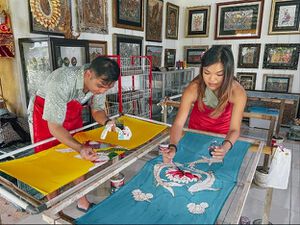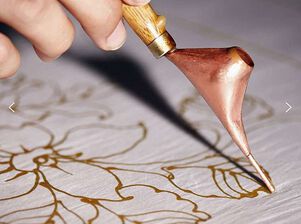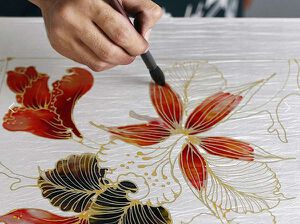Batik Paintings
To create a new page, enter a unique page name below.
If a page with that name already exists, you will be sent to a form to edit that page.
For existing pages ... see category Batik Paintings.
Fill in the form with the details of your image and save the page.
What is Batik
In simple term, Batik is an art to decorate cloth with wax as resist method. Derived from the Javanese words, amba (to write) and titik (dot), batik is an old form of art which loosely translated means to dot, while some have even translated it as wax writing or drawing with a broken line, batik is essentially a crafted fabric that needs to undergo the delicate and repeated process of waxing, dyeing and boiling. Wax is used as a mean of colour blocking in the colouring process. Every part of the fabric that remains untouched by a certain colour has to be covered with wax.
Batik techniques and process
Batik comprise of a process where a pattern or design is created with liquid wax on the cloth. This is done to protect the waxed area from being colored. So when the cloth is dipped in the color, the color does not enter the patch area which is waxed. The wax resists the colour and results into a surface which has dyed and un-dyed areas. This is how a pattern is made.
The dyes used for batik process has to be made only in vessels made of steel, plastic or enamel. This is because the properties of the material of the vessel can affect the dye. The first time when the cloth is dipped in the dye, lightest tone of the color should be used. In the old process of batik dyeing, artists were not allowed to use many colors in one go. But, with the development of advanced technology, modern techniques have been invented which makes the work of the artist easy. Now they can apply many colours using brush at one go.
Next, the cloth is again covered with wax on areas that have to retain the first colour. This process is carried out to get the darkest shade. The old Batik process involves many steps to obtain a particular shade. After the last dyeing, the fabric is placed between two layers of porous paper to dry. The wax has to be removed from the fabric onto the paper. This will give out the design that has been dyed on the fabric.
The important attribute of Batik is the cracks that appear in the design due to the wax. As the wax is frail, it cracks easy and the dye enters the waxed area. This creates a spider web design on places where wax has been applied. Normally, fabrics in pure form like pure cotton or silk is used for batik dyeing. This is because any mix in the fabric can hamper the effect of the colour on the cloth after washing.
Sarkasi Said 1940, Singapore
Singapore's renowned batik champion and Cultural Medallion winner, the late Sarkasi Said (1940–2021), who went by the artist name Tzee, was known for his bold and vibrant abstract style, and mastery of unconventional wax-resist techniques. His batik works were exhibited internationally and can be found in many public and private collections.
Sarkasi’s ‘Singapore orchid’ batik design was selected by the National Trades Union Congress for the Singapore Dress in the 1970s. During this period, he was known as the “Baron of Batik”. He set a Guinness World Record for the world’s longest batik painting in 2003. He also served on committees for the National Arts Council, Malay Museum Committee, and the Modern Art Society.
He was a recipient of Pingat APAD (APAD Award) in 1974, Best Foreign Entry (Sarasota Art Exhibition in the United States) in 1981, First Prize (Abstract) in the 8th UOB Painting of the Year (1989), Berita Harian Pioneer Generation Achiever Awards (2015) and the Cultural Medallion in 2020. He often donated to charitable organisations and volunteered to teach art at a drug rehabilitation centre. He passed away at the age of 81 in 2021.
ARTIST STATEMENT
"Batik is much more than just an artistic technique. It involves everything such as philosophy and history.
That is when a piece of work can be called batik—when it has everything. The design paints the social and
cultural essence of a community and every symbol, every line has meaning to it."
More info
Yogyakarta Art Batik Studio






